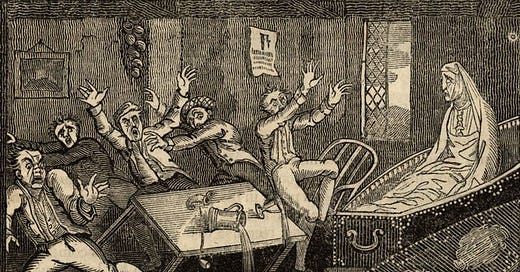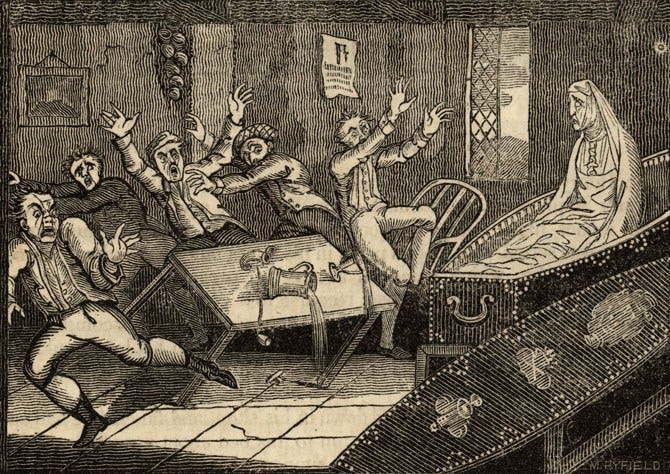What Exactly is a Near-Death Experience?
A simple question you might think, especially if you believe you know the answer. The term has been defined many times since it was coined by Dr. Raymond Moody in his classic 1975 book Life After Life. And while there’s seemingly endless debate over what exactly constitutes a near-death experience (or NDE), there is general agreement about what it signifies. But as a professional researcher of this phenomenon, I’m dismayed at how often misuses of the term are thrown around — in popular media and in conversations I have with people who are “dying” to tell me about their own NDE.
Since I’ll be writing about historical and cross-cultural NDEs on Medium in the future, I thought this would be a good post to start with: explaining exactly what an NDE is — and just as importantly, what it’s not. Let’s start with the latter.
What Isn’t a Near-Death Experience?
“I had a near-death experience,” an excited 30-something financial advisor named Shara told me at a party. She’d heard that I was an author of books about NDEs and was eager to share her own experience. Fair enough — I’m always interested to hear another account. “I was volunteering doing relief work in Africa, and I was riding on the back of a crowded flatbed truck,” Shara recounted. “A bus came toward us from the other direction and the road was too narrow for both vehicles. The side of the bus actually scraped along the the truck I was in, and I was just inches from being crushed between them.”
“And?” I asked.
“I was terrified! I could have died!” Shara was wide-eyed, waiting for my professional validation.
While Shara’s experience was undoubtedly frightening, and it clearly affected her deeply, it was not a “near-death experience.” It was what I’d call an IADE — an “I Almost Died Experience.” Or maybe a BWDE — a “Brush With Death Experience.”
Shara wasn’t alone in this misconception. Alleged celebrity NDEs in the tabloids usually end with the highly dissatisfying conclusion of “I almost died.” Take, for example, People magazine’s statement that alleged celebrities Khloé Kardashian and Scott Disick had a near-death experience because, they said, “we actually fell into the bay” and “kind of” almost died (and no, I’m not going to link it). People also reported on the alleged NDEs of David Arquette, Eminem, Chad Michael Murray, Liam Hemsworth, Zac Efron, Amy Schumer, Leonardo di Caprio, a woman who was attacked by a bison, and many others. Without exception, none of these people actually described having had NDEs. They either had a simple BWDE, and occasionally a genuine IADE.

The writers and editors at People may very well know better, and perhaps they’re just using the term as clickbait. Or they may just not understand what they’re supposedly writing about. But what about the entire creative team of the recent television comedy-fantasy series about the afterlife, The Good Place? Surely they would know what an NDE is? Nope. They misuse the term regularly throughout the show to mean — you guessed it — “Almost Died” or “Brush With Death.” Ironically, when the plot does involve actual NDEs, the writers are silent about them.
So What Is a Near-Death Experience?
To quote my most recent book, The Next World: Extraordinary Experiences of the Afterlife, NDEs are:
…spiritually interpreted episodes that individuals report having experienced during periods of clinical death or near-death. Though accounts vary greatly, typical features include sensations of leaving the body and existing in quasi- physical form; entering and emerging from darkness; bright light; visiting another realm; meeting deceased relatives; encountering beings that some associate with a particular religious figure; evaluation of one’s earthly life; feelings of joy, peace, oneness, transcendence, or unity; impressions of having returned “home”; exceptionally vivid awareness; reaching barriers or limits; clairvoyance or precognition; a return to the body sometimes following instructions to do so; reluctance to return; and subsequent positive transformations of the revived individual
Sticking with the celeb theme, here’s a good example from the late, great British comedian Peter Sellers:
“Well, I felt myself leave my body. I just floated out of my physical form and I saw them cart my body away to the hospital. I went with it. I was curious. I wondered what was wrong with me. I wasn’t frightened or anything like that because I was fine; and it was my body that was in trouble. Then I saw Dr. Kennamer come. And he felt my pulse and saw that I was dead. He and some other people pushed down and up on my chest. In fact, they pummeled the shit out of me…literally, I believe. They did everything but jump up and down on me to get my heart beating again. Then I saw Rex shout at somebody and say there was no time to prepare me for heart surgery. He commanded somebody to carve me open right there on the spot. Rex took my heart out of my body and massaged the hell out of it. Did everything but toss it up in the air. I was so curious watching him. He just refused to accept that I was dead.
“Then I looked around myself and I saw an incredibly beautiful bright loving white light above me. I wanted to go to that white light more than anything. I’ve never wanted anything more. I knew there was love, real love, on the other side of the light which was attracting me so much. It was kind and loving and I remember thinking, “That’s God.” I tried to elevate myself toward it as Rex was working on my heart. But somehow I couldn’t quite make it. Then I saw a hand reach through the light. I tried to touch it, to grab onto it, to clasp it so it could sweep me up and pull me through it. Then I heard Rex say below me, “It’s beating again. I’m getting a heartbeat.” At the same moment a voice attached to the hand I wanted to touch so much said, “It’s not time. Go back and finish. It’s not time.” The hand disappeared on the other side and I felt myself floating back into my body. I was bitterly disappointed. After that I don’t remember anything until I regained consciousness back inside my body.”

So, something a bit more profound than “kind of” almost dying after falling into the bay.
Sharon Stone has the distinction of having had two IADEs, as well as an actual NDE which resulted from a brain hemorrhage in 2001:
“I feel that I did die. This kind of giant vortex of light was upon me and — poof! I sort of took off into this glorious, white light. I started to see and be met by some of my friends … people who were very, very dear to me [who had died]. I had a real journey with this that took me to places both here and beyond. But it was very fast — whoosh! Suddenly, I was back. I was back in my body.”
She gives more details in this Oprah interview segment:
<a href="https://medium.com/media/07620b640b5a78f45722980131e894ec/href">https://medium.com/media/07620b640b5a78f45722980131e894ec/href</a>
So Why Does It Matter?
Look at it this way: what if your friend tells you that they had a religious experience, that it changed their life, and they’re excited to share it with you. Your curiosity is piqued and you’re eager to hear about it. Your friend then recounts how two very nice Jehovah’s Witnesses came to the door, and they talked about religion then shared a delicious recipe for flan.
The End. No burning bush, no vision of gods or other worlds, not even oneness with the universe. Just flan.
Same with NDEs. Confusing the relatively mundane experience of having a brush with death, with a profound, transformative spiritual experience devalues the significance of actual NDEs.
This is the case whether you believe they’re genuine spiritual experiences or not. I say this emphatically, and here’s why:
If you do believe that they’re genuine — or if you’re even open to the possibility, NDEs could be proof that consciousness survives the death of the physical body and lives on in some other dimension. If true, there is almost nothing more significant that human beings could possibly learn about ourselves — except maybe that there is other intelligent life in the universe.
If you don’t believe that NDEs are genuine, and think they’re just the special effects of a compromised brain, they’re still interesting as phenomena that have influenced the religions and cultures of the world far more than almost anybody realizes.
If you enjoyed this article, please consider becoming a Patron. Starting at just $1 a month, all Patrons receive a Historical Near-Death Experience of the Month, sent to all my subscribers twelve times a year. Depending on your subscription level, Patrons also receive books, discounts, exclusive content, updates on my various activities (articles, interviews, exclusive content, and books published by my new Afterworlds Press imprint), and more. If you’d like to sign up or learn more about the benefits available, please click here.
For more about me and my work, visit my website www.gregoryshushan.com. And check out my new book from White Crow, The Next World: Extraordinary Experiences of the Afterlife.






